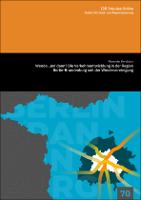Wende, und dann? Die Verkehrsentwicklung in der Region Berlin-Brandenburg seit der Wiedervereinigung
| dc.contributor.author | Kendziora, Alexander | |
| dc.date.accessioned | 2022-12-12T13:15:37Z | |
| dc.date.available | 2022-12-12T13:15:37Z | |
| dc.date.issued | 2022 | |
| dc.identifier.uri | https://library.oapen.org/handle/20.500.12657/60119 | |
| dc.description.abstract | With the German reunification the new Berlin-Brandenburg region had set itself the aim of an environmentally friendly and traffic-reducing settlement and transport policy. New settlement areas were to be created primarily along existing railway lines. Due to different interests, the cooperation of the two federal states encountered implementation difficulties on several occasions, so that the development that occurred fell short of the expectations that had been set for itself. The aim of this Master's thesis is to understand the development of transport in the Berlin-Brandenburg region, to identify key decisions and actors and to draw conclusions for further cooperation – especially against the background of the current challenges of a rapidly growing region. Therefore, this thesis analysed the relevant plans of the 1990s and compared them with the actual development using statistical data series on population development in the region. In addition, expert interviews were conducted to show further aspects of administrative cooperation. The analysis of settlement development shows that despite some implementation difficulties the overall management of the settlement development can be considered a success, also because the cooperation in spatial planning of the two federal states, as agreed in state treaties, is unique in Germany. In the field of transport planning, however, there is a lack of such continuity. The fact that guiding principles and objectives of planning partly contrast with one another makes cooperation in a region characterised by disparities even more difficult. It is therefore advisable to institutionalise transport planning in a joint planning authority, similar to spatial planning. To more precisely tailor transport and settlement policy in the future within a dynamically developing region the definition of the metropolitan area together with the guiding principles need to be adapted. Further research could examine the establishment of such a planning authority in the federal German framework in more detail. | en_US |
| dc.language | German | en_US |
| dc.relation.ispartofseries | ISR Impulse Online | en_US |
| dc.subject.classification | thema EDItEUR::R Earth Sciences, Geography, Environment, Planning::RP Regional and area planning::RPC Urban and municipal planning and policy | en_US |
| dc.subject.other | transport development; metropolitan area; public transportation; regional transportation; cooperation | en_US |
| dc.title | Wende, und dann? Die Verkehrsentwicklung in der Region Berlin-Brandenburg seit der Wiedervereinigung | en_US |
| dc.type | book | |
| oapen.identifier.doi | 10.14279/depositonce-12853 | en_US |
| oapen.relation.isPublishedBy | e5e3d993-eb32-46aa-8ee9-b5f168659224 | en_US |
| oapen.collection | AG Universitätsverlage | |
| oapen.series.number | 70 | en_US |
| oapen.pages | 108 | en_US |
| oapen.place.publication | Berlin | en_US |

